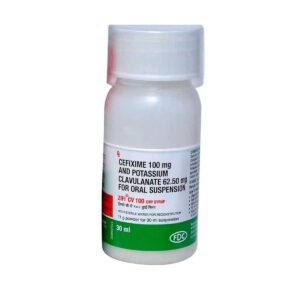CEFIXIME + CLAVULANIC ACID
Cefixime: Cefixime is an antibiotic medication used to treat various bacterial infections. It belongs to the class of drugs known as cephalosporins.
The medication works by inhibiting the formation of the bacterial cell wall, which is essential for the survival and growth of the bacteria. By preventing the bacteria from building a protective cell wall, cefixime stops their ability to multiply and eventually helps in eradicating the infection.
Cefixime is commonly prescribed for treating respiratory tract infections like bronchitis and pneumonia, urinary tract infections, gonorrhea, and certain sexually transmitted infections (STIs). It is effective against both gram-negative and some gram-positive bacteria.
The usual recommended oral dose for adults is 400 mg once daily or divided into two doses of 200 mg every 12 hours. The duration of treatment may vary depending on the type and severity of the infection, but it typically lasts for 7 to 14 days.
As with any medication, cefixime may cause side effects. Common side effects include diarrhea, nausea, stomach pain, headaches, dizziness, and skin rash. It is essential to inform your healthcare provider if any severe side effects occur, such as severe diarrhea, abdominal pain, or allergic reactions like difficulty breathing or swelling of the face, lips, tongue, or throat.
It is important to complete the full course of treatment prescribed by your healthcare provider, even if you start feeling better, to ensure the complete eradication of the infection and to prevent the development of antibiotic resistance.
Clavulanic Acid: Clavulanic Acid is a medication commonly used in combination with certain antibiotics to enhance their effectiveness. It is known as a beta-lactamase inhibitor, which means it helps to suppress the activity of beta-lactamase enzymes produced by some bacteria. These enzymes can break down and inactivate certain antibiotics, making them less effective in treating infections.
The primary use of Clavulanic Acid is as an adjunct to antibiotics such as amoxicillin, ampicillin, and ticarcillin. It is particularly effective against bacteria that produce beta-lactamase enzymes, which commonly occur in conditions such as urinary tract infections, respiratory tract infections, skin and soft tissue infections, and various other types of bacterial infections.
Clavulanic Acid works by irreversibly binding to beta-lactamase enzymes, inhibiting their activity and restoring the activity of the antibiotics they were inactivating. This allows the antibiotics to effectively kill the bacteria and treat the infection.
The dose of Clavulanic Acid can vary depending on the antibiotic it is being used with, as well as the severity and type of infection. It is usually taken orally, either with or without food. It is important to follow the prescribed dosage and duration of treatment as instructed by your healthcare provider.
As with any medication, Clavulanic Acid may cause certain side effects. Common side effects include diarrhea, nausea, and vomiting. If any of these side effects persist or worsen, it is important to consult a healthcare professional. In rare cases, more severe side effects such as allergic reactions, liver problems, or blood disorders may occur, and immediate medical attention should be sought if any of these occur.
It is important to inform your healthcare provider about any allergies, medical conditions, or medications you are currently taking before starting Clavulanic Acid to ensure its safe and effective use.



